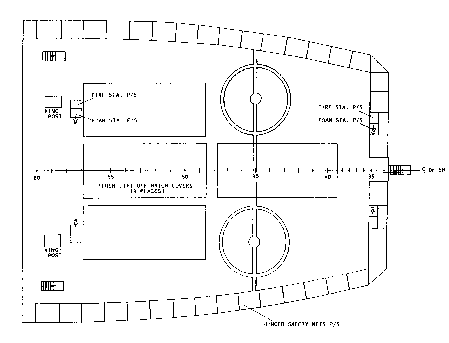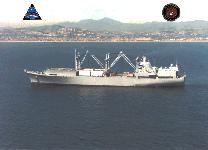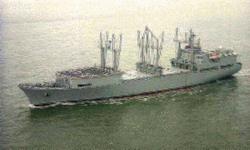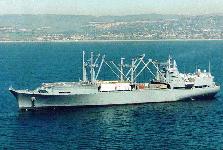




In response to the urgent need to improve responsiveness and reduce airlift requirements during the critical initial stages of major force deployments, in the mid 1980s the United States Navy procured two (2) Roll-on/Roll-off Cargo Container ships (T-AVBs) to transport intermediate level aviation for support within a contingency area -- the USNS Wright and the USNS Curtiss. In addition, at about the same time, the Marine Corps introduced the Marine Aviation Logistics Support Program (MALSP) to ensure quick response times for crisis situations. MALSP ensured tailored support for a task organized Aviation Combat Element (ACE).
The T-AVB is a C5-s-78a Seabridge class, commercial, combination Container, Roll On/Roll Off (RO/RO) and Lift On/Lift Off (LO/LO) cargo ship adapted by Military Sealift Command (MSC) for use by the Marine Corps. Both T-AVB ships were acquired as a result of a Marine Corps "Feasibility Study of the Aviation Logistics Support Ship" dated 25 NOV 83. The ships have been modified for use by USMC I-Level aviation maintenance and supply organizations. The USNS Wright is presently berthed at Baltimore, MD, and the USNS Curtiss is berthed at Port Hueneme, CA. The Curtis supports the 2nd Marine Aircraft Wing, MCAS Cherry Point NC, while the Wright supports the 3rd Marine Aircraft Wing MCAS EL Toro CA. The ships are maintained in a five day Reduced Operating Status (ROS-5) by the Maritime Administration (MARAD). The ROS-5 status allows for a transition to full operating status within 120 hours. A civilian commercial US Merchant Marine crew is stationed aboard each ship to monitor equipment conditions and conduct vessel maintenance and repair. When activated, the ships are operated by the Military Sealift Command with civilian manning. During Operation Desert Shield the 3d Marine Aircraft Wing from southern California deployed to the Persian Gulf along with these two specialized aviation logistics support ships. In the late 1980's the Marine Corps introduced the Marine Aviation Logistics Support Program (MALSP). MALSP incorporates a flexible "building-block concept," known as Contingency Support Packages (CSPs), that follows a pre-arranged deployment/employment scenario for assembling the right mix of Marines, support equipment, mobile facilities, and spare parts within a Marine Aviation Logistics Squadron (MALS) to support deployed aircraft. The key word is "flexible." Contingency support packages can be rapidly configured to support the contingency aircraft mix and marshaled for movement. CSPs are comprised of common and peculiar IMA and Supply support for the various deploying aircraft. Fly In Support Packages (FISPs)(30 days of support) are flown into the operational theater as part of the Fly-In Echelon (FIE). The balance/majority of the Marine Air/Ground Task Force (MAGTF) commander's tailored aviation logistics support arrives in theater aboard the T-AVB. These converted ships provide the capability to carry the vans and equipment of a Marine Corps aviation intermediate maintenance activity and transport them to the desired theatre of operation. They have both a roll-on/roll-off and self-sustaining containership configuration which will permit them to offload both alongside and offshore. After the aviation equipment is offloaded, the ships have the capability to carry breakbulk, container and roll-on/roll-off cargo. Three basic modes of operation exist for the T-AVB; Operational Mode,Transport Mode and Combination Mode.Specifications | |
| Displacement, Full Load | 23,800 LT |
| Length | Overall 602 Ft. Waterline 560 ft |
| Beam | 90 Ft. |
| Draft (Scantling) | 34 Ft. |
| Draft Full Load (Mean) | 29.8 Ft. |
| Shaft Horsepower (ABS) | 30,000 HP |
| Accommodations |
Ship Crew 41 Embarked Troops 300 Officer/SNCO 25 Total Accommodations 366 |
| Fuel Capacity | 3,200 LT Bunker C |
| Speed at 80% power | 18 Knots |
| Light Ship Weight | 14,000 LT |
| Containers | Twenty Foot Equivalent Units (TEUs) 608
Maximum capacity in transport mode using 8'x8'x20' containers. In the IMA mode, 300 MFs and 52 Access Modules are carried. |
Ships | ||||||
| Name | Number | Builder | Homeport | Ordered | Commissioned | Decommissioned |
| Wright | T-AVB 3 | Ingalls | Baltimore | 01 May 1986 | ||
| Curtiss | T-AVB 4 | Ingalls | Hueneme | 18 Aug 1987 | ||





